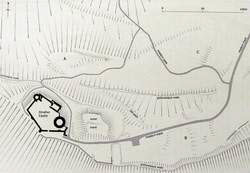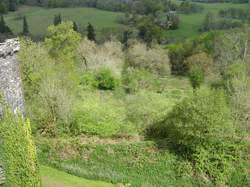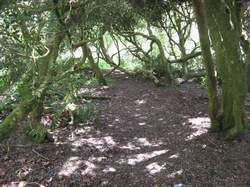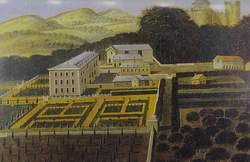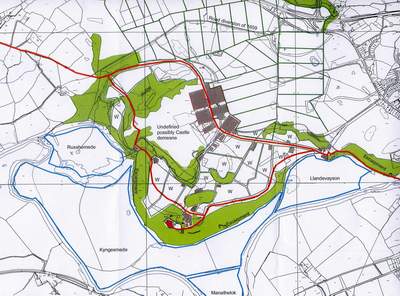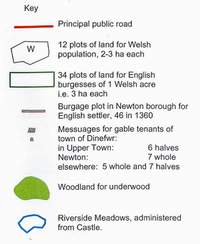Abandoned Communities ..... Tywi Valley
We have seen that Dinefwr fell to the English in 1277. At that time there was a settlement close to the castle. Its precise location has not been established, but it probably lay on relatively level ground beside the road approaching the castle or below the castle on the north eastern side. It may have occupied both these sites.
Archaeological investigation under Ken Murphy of the Dyfed Archaeological Trust has failed to provide clear evidence of the township, but the excavations were limited by the fact that the area is now a Site of Special Scientific Interest managed by the Wildlife Trust of South and West Wales. The report by the Dyfed Archaeological Trust can be found on their website.
The original Welsh residents of the town at Dinefwr did not receive full burgage rights. Instead they were referred to as gavel tenants in reeves' reports near the end of the twelfth century. As at Dryslwyn immigrants were encouraged to settle at Dinefwr. Before long it was decided that a separate settlement was needed for their benefit and Newton was created east of the castle, in the area where Newton House now stands.
The exact location of Newton is not known, but it is thought that three rectangular areas on a painting of around 1700 may represent the remnants of individual burgage plots. In addition the report by the Dyfed Archaeological Trust presents findings from geophysical surveys that may indicate features of the medieval town, including a ditch that may have marked the western boundary of the town, the line of the main street, and possible burgage plots about 10 metres wide and at least 50 metres long.
In 1302-03 Newton had 35 burgages, and in addition the burgesses held 34 acres of land outside the town. Of the 25 gavel tenants in the old settlement all but one had Welsh names, while only ten of the householders in Newton were Welsh. One man, John Peny, held land in both.
In 1300 the constable of Dinefwr castle, Henry Scurlage, received £40 a year from the crown to maintain a garrison of 24 men. He also received income from the mill (8s), 8 acres of demesne land (13s 4d), the fishery on the Tywi (20s), and locally brewed beer called Tolcester (10s).
In 1310-11 Edmund Hakelut, then constable of the castle, was granted the castle, town, and demesnes of Dinefwr for life, and when he died in 1338 his son, another Edmund, inherited these rights. The financial and administrative records from the period when Dinefwr was governed by the Hakelut family have not survived.
After the death in 1360 of the younger Edmund Hakelut we have the accounts of the eight months between February and September that year. Income included rents amounting to £1 15s 4d from the bondmen of the old town, £2 6s from 46 burgages in Newton, and 14s 1d from other tenants in Newton. The mention of bondmen indicates that residents of the old town still had lower status.
Other income received in 1360 from the reeve of the old town included rent for the King's Meadows (24s), rent from the mill (8s 10¾d), and rent from the fishery (13s 4d). 11s 8d was raised from the sale of 14 salmon, and 18½ bushels of assorted grain and 10 bushels of beans were sold for £9 13s 6d. No income came from the orchard that year due to the dry weather. Payments amounting to £1 18s were made for such services as repairs, carriage of timber, haymaking, and strengthening the river bank.
Based mainly on the information from the 1360 accounts Colvin and Moggridge have produced a map with a hypothetical presentation of Dinefwr estate as it may have been at that time. The map comes in an unpublished report for the National Trust, Parc Dinefwr: Designed Landscape Survey, 2003. Part of it is reproduced at the foot of this page.
In Newton the largest single source of income was £4 for fair tolls during the Feast of the Nativity of Holy Mary. It is clear that while the inhabitants of the old town were expected to provide a range of services people living in Newton were more likely to be involved in commerce. This difference was consolidated in 1363 when the first charter was granted to Newton. The charter confirmed the town's status as a borough, and it gave the burgesses the right to select their own officials. They were exempted from paying tolls in other towns, and a second three day fair was granted.
The official English view of the Welsh becomes apparent again in a decision by Richard II in 1392 that the burgesses of Newton could not be convicted by any Welshman in any felonies, rights, injuries, crimes, or demands. This privilege was given “in consideration of the great losses and oppressions sustained through the malice of the Welsh of those parts”.
Archaeological investigation under Ken Murphy of the Dyfed Archaeological Trust has failed to provide clear evidence of the township, but the excavations were limited by the fact that the area is now a Site of Special Scientific Interest managed by the Wildlife Trust of South and West Wales. The report by the Dyfed Archaeological Trust can be found on their website.
The original Welsh residents of the town at Dinefwr did not receive full burgage rights. Instead they were referred to as gavel tenants in reeves' reports near the end of the twelfth century. As at Dryslwyn immigrants were encouraged to settle at Dinefwr. Before long it was decided that a separate settlement was needed for their benefit and Newton was created east of the castle, in the area where Newton House now stands.
The exact location of Newton is not known, but it is thought that three rectangular areas on a painting of around 1700 may represent the remnants of individual burgage plots. In addition the report by the Dyfed Archaeological Trust presents findings from geophysical surveys that may indicate features of the medieval town, including a ditch that may have marked the western boundary of the town, the line of the main street, and possible burgage plots about 10 metres wide and at least 50 metres long.
In 1302-
In 1300 the constable of Dinefwr castle, Henry Scurlage, received £40 a year from the crown to maintain a garrison of 24 men. He also received income from the mill (8s), 8 acres of demesne land (13s 4d), the fishery on the Tywi (20s), and locally brewed beer called Tolcester (10s).
In 1310-
After the death in 1360 of the younger Edmund Hakelut we have the accounts of the eight months between February and September that year. Income included rents amounting to £1 15s 4d from the bondmen of the old town, £2 6s from 46 burgages in Newton, and 14s 1d from other tenants in Newton. The mention of bondmen indicates that residents of the old town still had lower status.
Other income received in 1360 from the reeve of the old town included rent for the King's Meadows (24s), rent from the mill (8s 10¾d), and rent from the fishery (13s 4d). 11s 8d was raised from the sale of 14 salmon, and 18½ bushels of assorted grain and 10 bushels of beans were sold for £9 13s 6d. No income came from the orchard that year due to the dry weather. Payments amounting to £1 18s were made for such services as repairs, carriage of timber, haymaking, and strengthening the river bank.
Based mainly on the information from the 1360 accounts Colvin and Moggridge have produced a map with a hypothetical presentation of Dinefwr estate as it may have been at that time. The map comes in an unpublished report for the National Trust, Parc Dinefwr: Designed Landscape Survey, 2003. Part of it is reproduced at the foot of this page.
In Newton the largest single source of income was £4 for fair tolls during the Feast of the Nativity of Holy Mary. It is clear that while the inhabitants of the old town were expected to provide a range of services people living in Newton were more likely to be involved in commerce. This difference was consolidated in 1363 when the first charter was granted to Newton. The charter confirmed the town's status as a borough, and it gave the burgesses the right to select their own officials. They were exempted from paying tolls in other towns, and a second three day fair was granted.
The official English view of the Welsh becomes apparent again in a decision by Richard II in 1392 that the burgesses of Newton could not be convicted by any Welshman in any felonies, rights, injuries, crimes, or demands. This privilege was given “in consideration of the great losses and oppressions sustained through the malice of the Welsh of those parts”.
Four
Dinefwr castle and the surrounding area. The likely locations for the town are marked A and B.
Looking down towards Area A, where part of the town may have been.
Woodland in Area B
Painting of Newton House and part of the estate done by an unknown artist around 1700. The three possible burgage plots appear on the right.
This painting is on display in
Newton House.
A hypothetical representation of the Dinefwr estate as it may have been in 1360
